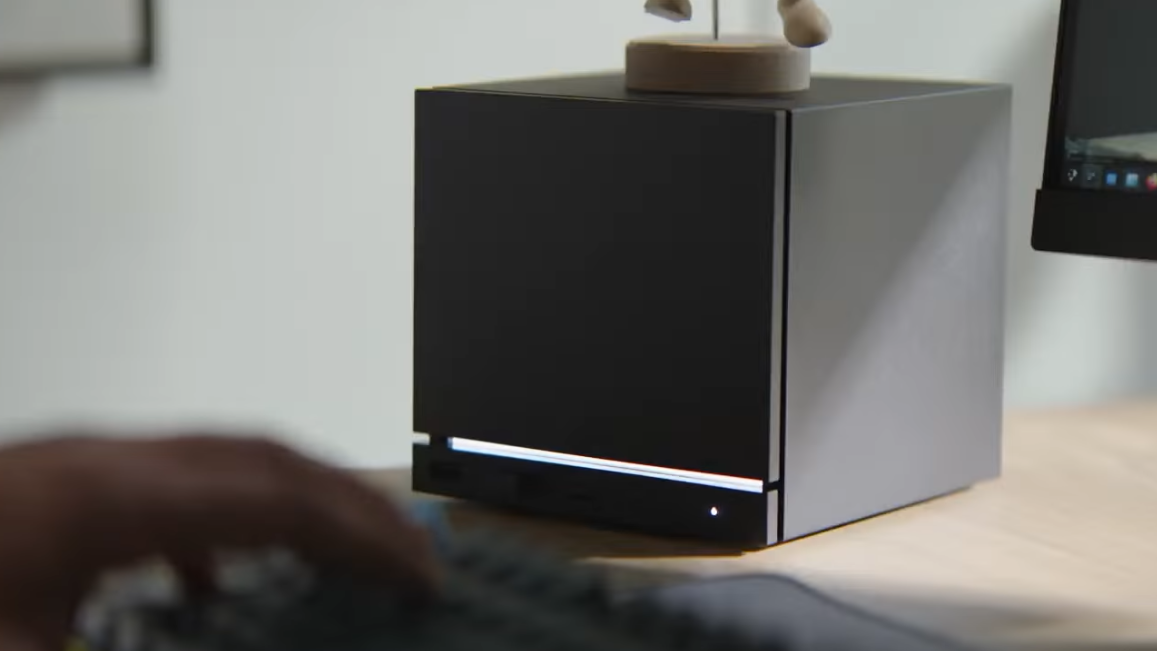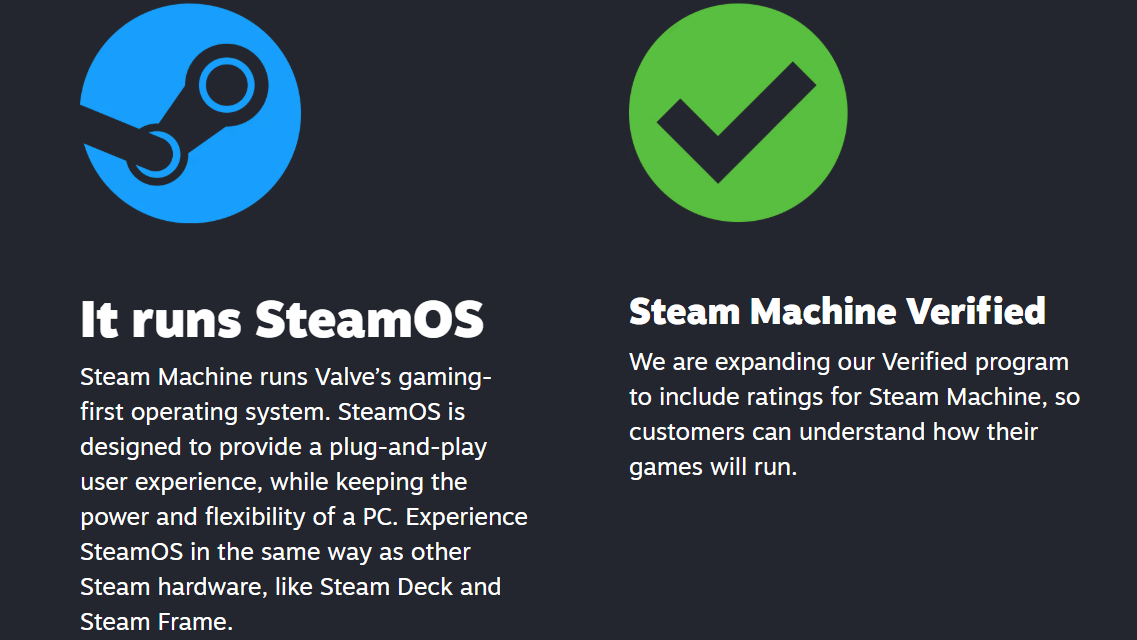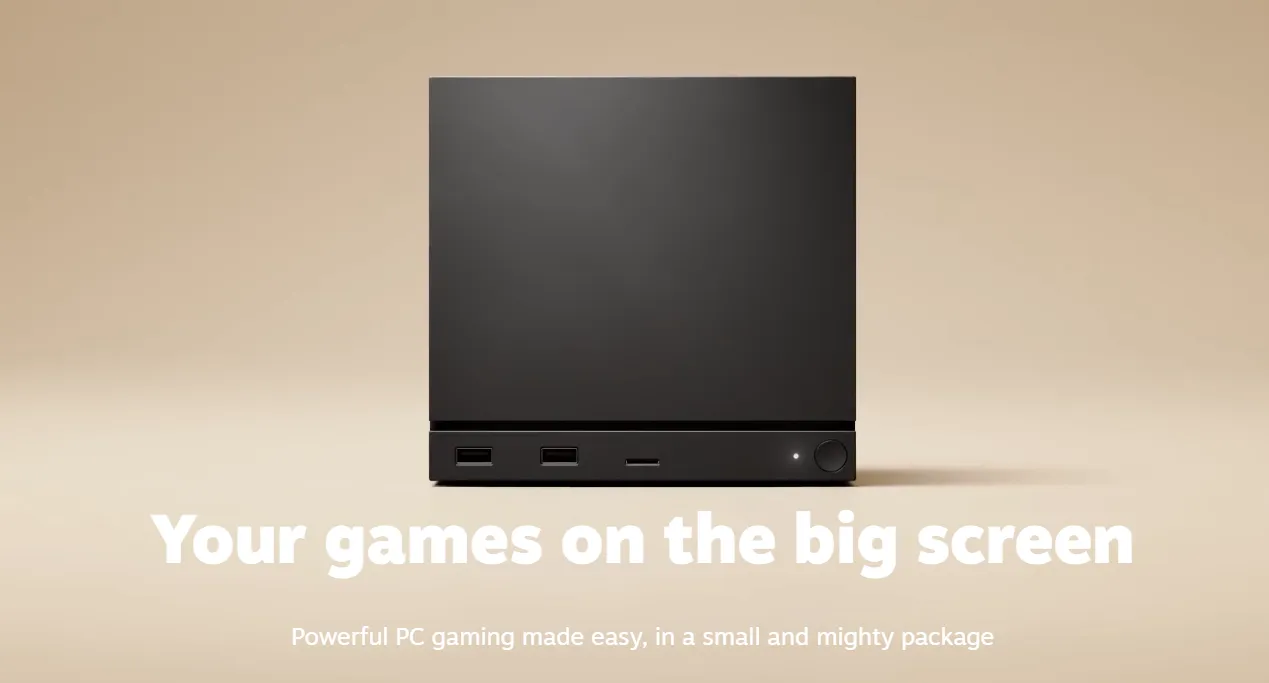Steam Machine is a compact, SteamOS-powered living-room PC designed to run your Steam library from the couch. It uses desktop-class AMD silicon in a small cube chassis, ships in two storage configurations, and integrates cleanly with a new low‑latency Steam Controller. A release window is set for early 2026; pricing has not been announced.
Steam Machine specs (summary)
| Spec | Details (pre‑release) |
|---|---|
| Models | 512GB or 2TB; available standalone or bundled with the new Steam Controller |
| Dimensions | 156 × 152 × 162 mm |
| CPU | Semi‑custom AMD Zen 4, 6 cores / 12 threads, up to 4.8 GHz, ~30 W TDP |
| GPU | Semi‑custom AMD RDNA 3, 28 compute units, up to 2.45 GHz sustained, 8GB GDDR6 VRAM, ~110 W TDP |
| System RAM | 16GB DDR5 SO‑DIMM (upgradeable) |
| Storage | M.2 NVMe SSD (2230 by default; 2230/2280 supported); configurations: 512GB or 2TB |
| Storage expansion | microSD slot (SDXC) |
| Video outputs | DisplayPort 1.4 (up to 4K 240 Hz / 8K 60 Hz, HDR, FreeSync, daisy‑chain); HDMI 2.0 (up to 4K 120 Hz, HDR, FreeSync, CEC) |
| USB & I/O | 1× USB‑C 3.2 Gen 2 (10 Gbps), 2× USB‑A 3.x (front), 2× USB‑A 2.0 (rear), 1 Gbps Ethernet, no Thunderbolt |
| Wireless | Wi‑Fi 6E (2×2), Bluetooth (dedicated antenna), integrated 2.4 GHz radio for Steam Controller |
| Power | Internal PSU, 110–240 V AC (approx. 200 W) |
| OS & UX | SteamOS 3 (Arch‑based, KDE Plasma), fast suspend/resume, Steam Cloud; user‑installable alternate OS supported |
| Design features | Customizable front LED bar; magnetic, replaceable front faceplate; wake with Steam Controller |
| Performance target | 4K gaming at 60 fps using FSR upscaling; ray tracing supported; “over 6×” Steam Deck performance |

Displays, ports, and connectivity
- Two display paths: DisplayPort 1.4 for high‑refresh 4K (up to 240 Hz) or 8K 60 Hz with HDR/FreeSync; HDMI 2.0 for up to 4K 120 Hz with HDR/FreeSync and TV control via CEC.
- USB layout favors living‑room use: two front USB‑A 3.x for controllers/dongles, rear USB‑A 2.0 for low‑bandwidth peripherals, and one 10 Gbps USB‑C on the rear. There is no Thunderbolt.
- Networking includes 1 Gbps Ethernet and Wi‑Fi 6E (2×2). Bluetooth uses a dedicated antenna to reduce contention with Wi‑Fi, and the system includes a dedicated 2.4 GHz radio for the Steam Controller.
Storage and upgrades
- Boot drive: M.2 NVMe (2230 form factor by default). The board includes support for 2280 drives using the provided standoff.
- Expandable storage: microSD slot (SDXC) for additional library capacity and easy shuttling of games between devices.
- Memory: 16GB DDR5 SO‑DIMM is user‑replaceable; RAM access is more involved than the SSD swap due to the compact thermal assembly.
Size, cooling, and acoustics
- Compact “cube” chassis (roughly 6 inches per side) with an internal 200 W power supply to simplify cabling and fit into media cabinets.
- Single, large shared heatsink spans CPU, GPU, memory, and power delivery; a custom 120 mm rear fan moves air through the stack.
- The enclosure integrates RF shielding by using the PSU structure as part of the chassis, reducing brackets and complexity.
- Front LED bar is user‑configurable for color and status cues (downloads, boot, updates), and the magnetic faceplate is removable for cleaning or customization.
Performance targets and practical expectations
The design target is 4K60 in modern titles with AMD FSR upscaling, with ray tracing supported. In demanding games, expect to tune settings and FSR quality modes to stay near that 60 fps objective. The GPU’s 28‑CU RDNA 3 configuration, 2.45 GHz sustained clocks, and 8GB of GDDR6 VRAM place it in the mid‑range class, with power budgets (CPU ~30 W, GPU ~110 W) aligned to the system’s compact cooling and 200 W PSU envelope.
For couch play on a 4K TV, upscaling from a 1440p‑class render is the intended path. Less demanding titles and esports games can push higher refresh rates at 1080p/1440p, while heavier ray‑traced workloads will benefit from balanced or performance‑oriented FSR presets.
Software and flexibility
- Ships with SteamOS 3 (Arch‑based, KDE Plasma) and the same living‑room interface found on Steam Deck, including suspend/resume and Cloud saves.
- Open PC approach: You can install other operating systems and third‑party applications if desired.
- The microSD slot provides a convenient way to move part of your library between the Steam Machine, the Steam Deck, and a PC.

Models, release window, and availability
- Two SKUs at launch: 512GB and 2TB NVMe SSD models; both offered standalone or in a bundle with the new Steam Controller.
- Release timing: early 2026. Pricing has not been disclosed.
- Distribution will follow the established Steam hardware model and regions used for Steam Deck.
Controller integration (Steam Controller highlights)
- Low‑latency wireless via a small “puck” receiver (around 8 ms end‑to‑end, up to four controllers per puck), plus Bluetooth and USB support.
- TMR magnetic thumbsticks for precision and drift resistance, dual trackpads with HD haptics, and gyro with GripSense activation.
- Rated 35+ hours per charge; the console can wake from the controller. Steam Machine includes a built‑in 2.4 GHz radio for direct pairing.
In short, Steam Machine targets a stable, console‑like 4K experience through upscaling in a compact box that keeps PC flexibility intact. The hardware balance—Zen 4 CPU, RDNA 3 GPU, and practical thermals—aims for consistency on a well‑understood baseline, with user‑serviceable storage and memory to extend its useful life. Final pricing and any last‑mile spec tweaks will determine how well it lands against traditional consoles and entry‑level gaming PCs.


